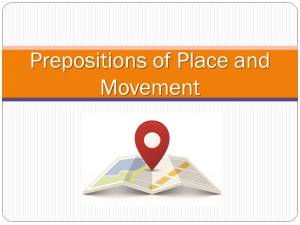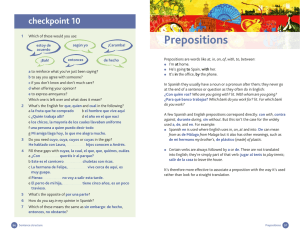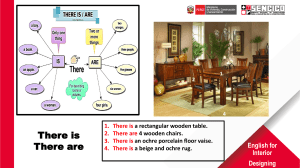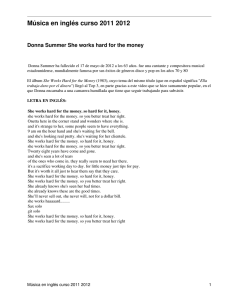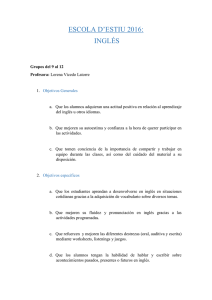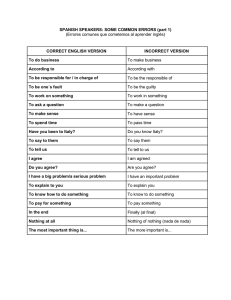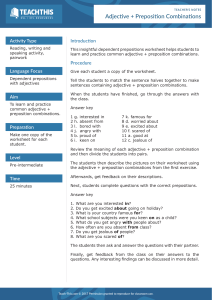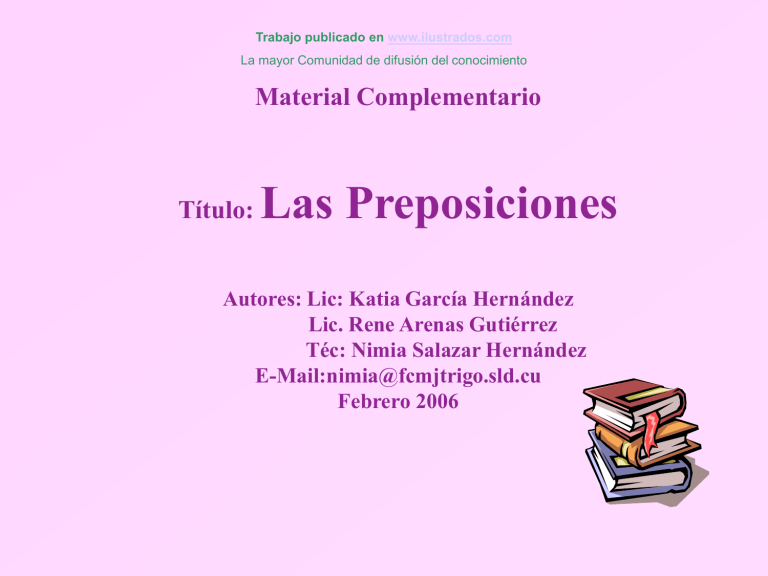
Trabajo publicado en www.ilustrados.com La mayor Comunidad de difusión del conocimiento Material Complementario Título: Las Preposiciones Autores: Lic: Katia García Hernández Lic. Rene Arenas Gutiérrez Téc: Nimia Salazar Hernández E-Mail:nimia@fcmjtrigo.sld.cu Febrero 2006 Índice » Introducción ………………3 » Desarrollo………………….4-15 » Datos de los autores ……….16 Introducción Las preposiciones son palabras muy útiles, pero también muy difíciles de usar correctamente en cualquier idioma. Sin embargo, para leer en Inglés el lector sólo debe conocer que cada preposición suele tener uno o dos significados básicos, aunque tenga otras posibilidades de traducción. Después debe adiestrarse en cambiar la traducción literaria de una preposición del Inglés al pasarla al español si eso fuera necesario por su uso en nuestra lengua materna. Por ejemplo, en inglés se dice: The man in the white suit, que equivale a decir en español: El hombre del traje blanco. Igualmente en una frase como:...a package from Spain, la preposición from significa desde (lugar de procedencia); en español se dice:...un paquete de España. Desarrollo Uno debe familiarizarse completamente con las preposiciones más usuales y significados básicos, tal y como aparecen a continuación. Pero debe tener presente que con frecuencia tendrá que recurrir al diccionario para buscar otros significados cuando compruebe que los que aquí se presentan no se adecuan al contexto determinado que está leyendo. after against along among at before behind below beneath beside between beyond but by después contra a lo largo de, junto con entre en ante tras, detrás bajo bajo al lado de entre detrás de, más allá de excepto, a excepción de por, al lado de concerning despite down during except for from in in front of inside in regard to in spite of into like respecto a a pesar de bajo durante a excepción de, excepto para, por, durante desde, de en delante dentro respecto a a pesar de hacia adentro como near next to of on outside over regarding since through till throughout to toward(s) under underneath until up upon cerca al lado de de sobre fuera de encima, sobre respecto a desde a través de hasta a través de, a lo largo de a, para hacia bajo bajo, debajo hasta arriba en, sobre with within without con dentro de sin A REVIEW OF PREPOSITIONS: A preposition is used to connect nouns and noun structures in the sentece. A noun structure following the preposition is called the object of the preposition. The object of the preposition can be: A noun: We gave a present to our secretaries. A pronoun: We gave a present to them. A gerund: We thought about giving a present to them. A noun clause: We thought about giving a present to whoever worked for us. Placement of prepositions: The preposition is usually placed before the object. But it may be placed at the end of a sentece in: A question: Which country did you go to? An adjetive clause: This map shows the countries which we went to. A noun clause: We forget which countries we went to. An adjectival prepositional phrase is placed after the noun it modifies. The book on the desk is mine. The dog next door bothers me. An adverbial prepositional phrase, like any adverb, may be placed anywhere in the sentece. Or it may be placed at the: End: I came at nine o’clock. Middle: He leaves in two hours to visit his friends. Beginning: On Monday, I have my French class. Types of prepositions: There are one-and two-word prepositions: One-word: in, at, over, among Two-word: next to, instead of There are times when prepositions can be used without objects. At such times, they no longer function as prepositions but become either (1) two-word verbs; (2) adverbs; or(3) conjuctions. Two-word verbs (verb+particle) Examples: bring up (raise) find out (discover) call off (cancel) catch on (understand) These combinations have idiomatic meanings. Adverb: Example: Did you take the elevator? No, we walked up. Conjuctions: Examples: He came before I did. Please, come before the meeting starts. Prepositions: Prepositions show relationships in time and space and relationships between ideas (logical relationships). Learn the set phrases with prepositions of space. Harry lives in Denver. (a city) inColorado. (a state or province) on Green Avenue. (street without a number) at 261 Green Avenue. (street with a number) in Room 261 or Apartment 210-A. (specific room or apartment) Harriet’s friend live in Canada. (country) At or away from home. On a farm. In a dormitory, house, student hostel. In poverty, wealth, a city, a suburb, a town, a village. In the South, West. (region or section) The plane landed in Chicago At O’Hare Airport At the Chicago airport. Harriet lives at 261 Green Avenue, Denver, Colorado. The plane landed at O’Hare Airport, Chicago. We are going to visit my cousin in Denver. He is in college. At the university. Their house is (located) on the beach. On the ocean. At the shore. In the mountains. On the river, bay, lake. In the dessert. On the plains. Note: When you do not put a preposition between different pieces of information about a place, use a comma. Prepositions that show apace and movement often introduce essential information that tells you wich one. These phrases are adjetive phrases and follow the noun or pronoun they modify. The buses in the city run every ten minutes. The houses on the bay were damaged by the hurricane. Learn the set phrases of time. Paul always comes at ten o’clock. (specific time) On time. In time for class. Paul visited Canada in 1980. (year) In May. (month) On May 18. (date) On Wednesday. (day of the week) In the morning, afternoon, evening, daytime, the right. At noon, midnight, night. Datos de los Autores • MSc: Katia C. García Hernández Profesor Principal Inglés Instituto Profesor Auxiliar Inglés Facultad de Ciencias Médicas “Julio Trigo López” • Nimia Salazar Hernández Asistente Técnico docente de Informática Facultad de Ciencias Médicas “Julio Trigo López” • MSc: René Arenas Gutiérrez Jefe de Departamento Investigaciones Profesor Auxiliar Informática Facultad de Ciencias Médicas “Julio Trigo López”

